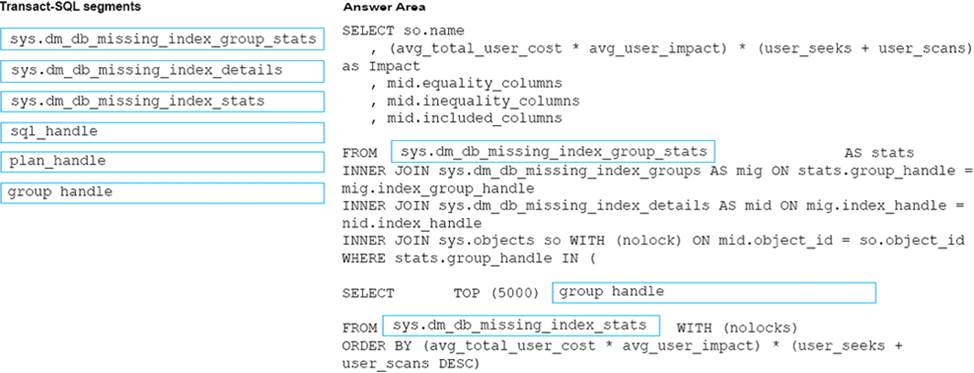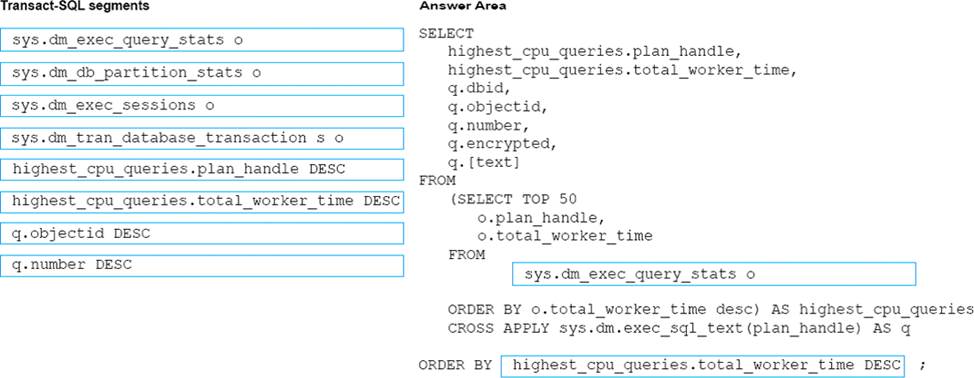Microsoft 70-762 Developing SQL Databases Online Training
Microsoft 70-762 Online Training
The questions for 70-762 were last updated at Jan 27,2025.
- Exam Code: 70-762
- Exam Name: Developing SQL Databases
- Certification Provider: Microsoft
- Latest update: Jan 27,2025
Note: This question is part of a series of questions that use the same answer choices. An answer choice may be correct for more than one question on the series. Each question is independent of the other questions in this series. Information and details provided in a question apply only to that question.
You work on an OLTP database that has no memory-optimized file group defined.
You have a table names tblTransaction that is persisted on disk and contains the information described in the following table:
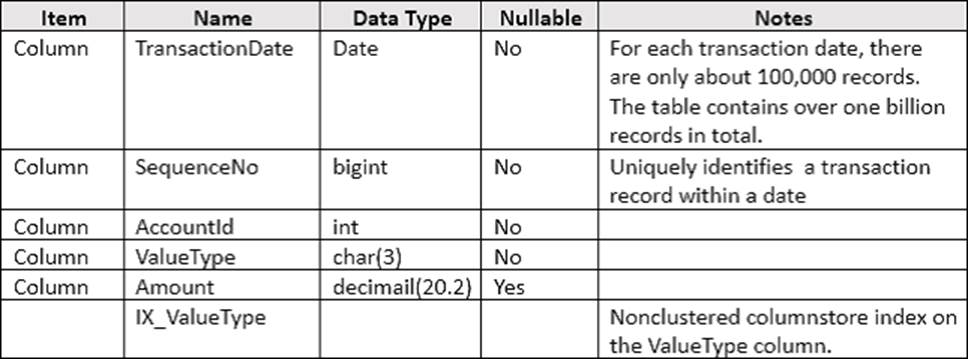
Users report that the following query takes a long time to complete.

You need to create an index that:
– improves the query performance
– does not impact the existing index
– minimizes storage size of the table (inclusive of index pages).
What should you do?
- A . Create aclustered index on the table.
- B . Create a nonclustered index on the table.
- C . Create a nonclustered filtered index on the table.
- D . Create a clustered columnstore index on the table.
- E . Create a nonclustered columnstore index on the table.
- F . Create a hashindex on the table.
Note: This question is part of a series of questions that use the same answer choices. An answer choice may be correct for more than one question on the series. Each question is independent of the other questions in this series. Information and details provided in a question apply only to that question.
You work on an OLTP database that has no memory-optimized file group defined.
You have a table names tblTransaction that is persisted on disk and contains the information described in the following table:

Users report that the following query takes a long time to complete.

You need to create an index that:
– improves the query performance
– does not impact the existing index
– minimizes storage size of the table (inclusive of index pages).
What should you do?
- A . Create aclustered index on the table.
- B . Create a nonclustered index on the table.
- C . Create a nonclustered filtered index on the table.
- D . Create a clustered columnstore index on the table.
- E . Create a nonclustered columnstore index on the table.
- F . Create a hashindex on the table.
Note: This question is part of a series of questions that use the same answer choices. An answer choice may be correct for more than one question on the series. Each question is independent of the other questions in this series. Information and details provided in a question apply only to that question.
You work on an OLTP database that has no memory-optimized file group defined.
You have a table names tblTransaction that is persisted on disk and contains the information described in the following table:

Users report that the following query takes a long time to complete.

You need to create an index that:
– improves the query performance
– does not impact the existing index
– minimizes storage size of the table (inclusive of index pages).
What should you do?
- A . Create aclustered index on the table.
- B . Create a nonclustered index on the table.
- C . Create a nonclustered filtered index on the table.
- D . Create a clustered columnstore index on the table.
- E . Create a nonclustered columnstore index on the table.
- F . Create a hashindex on the table.
FirstName must be added to the index as an included column.
What should you do?
- A . Create a clustered index on the table.
- B . Create a nonclustered index on the table.
- C . Create a nonclustered filtered index on the table.
- D . Create a clustered columnstore index on the table.
- E . Create a nonclustered columnstore index on the table.
- F . Create a hash index on the table.
Note: The question is part of a series of questions that use the same or similar answer choices. An answer choice may be correct for more than one question in the series. Each question is independent of the other question in the series. Information and details provided in a question apply only to that question.
You have a reporting database that includes a non-partitioned fact table named Fact_Sales. The table is persisted on disk. Users report that their queries take a long time to complete. The system administrator reports that the table takes too much space in the database. You observe that there are no indexes defined on the table, and many columns have repeating values.
You need to create the most efficient index on the table, minimize disk storage and improve reporting query performance.
What should you do?
- A . Create a clustered index on the table.
- B . Create a nonclustered index on the table.
- C . Create a nonclustered filtered index on the table.
- D . Create a clustered columnstore index on the table.
- E . Create a nonclustered columnstore index on the table.
- F . Create a hash index on the table.
Note: The question is part of a series of questions that use the same or similar answer choices. An answer choice may be correct for more than one question in the series. Each question is independent of the other question in the series. Information and details provided in a question apply only to that question.
You have a database named DB1. The database does not use a memory-optimized filegroup. The database contains a table named Table1.
The table must support the following workloads:

You need to add the most efficient index to support the new OLTP workload, while not deteriorating the existing Reporting query performance.
What should you do?
- A . Create a clustered index on the table.
- B . Create a nonclustered index on the table.
- C . Create a nonclustered filtered index on the table.
- D . Create a clustered columnstore index on the table.
- E . Create a nonclustered columnstore index on the table.
- F . Create a hash index on the table.
Note: The question is part of a series of questions that use the same or similar answer choices. An answer choice may be correct for more than one question in the series. Each question is independent of the other question in the series. Information and details provided in a question apply only to that question.
You have a database named DB1. The database does not have a memory optimized filegroup.
You create a table by running the following Transact-SQL statement:

The table is currently used for OLTP workloads. The analytics user group needs to perform real-time operational analytics that scan most of the records in the table to aggregate on a number of columns. You need to add the most efficient index to support the analytics workload without changing the OLTP application.
What should you do?
- A . Create a clustered indexon the table.
- B . Create a nonclustered index on the table.
- C . Create a nonclustered filtered index on the table.
- D . Create a clustered columnstore index on the table.
- E . Create a nonclustered columnstore index on the table.
- F . Create a hash index on the table.
DRAG DROP
You are analyzing the performance of a database environment.
You suspect there are several missing indexes in the current database.
You need to return a prioritized list of the missing indexes on the current database.
How should you complete the Transact-SQL statement? To answer, drag the appropriate Transact-SQL segments to the correct locations. Each Transact-SQL segment may be used once, more than once or not at all. You may need to drag the split bar between panes or scroll to view content.
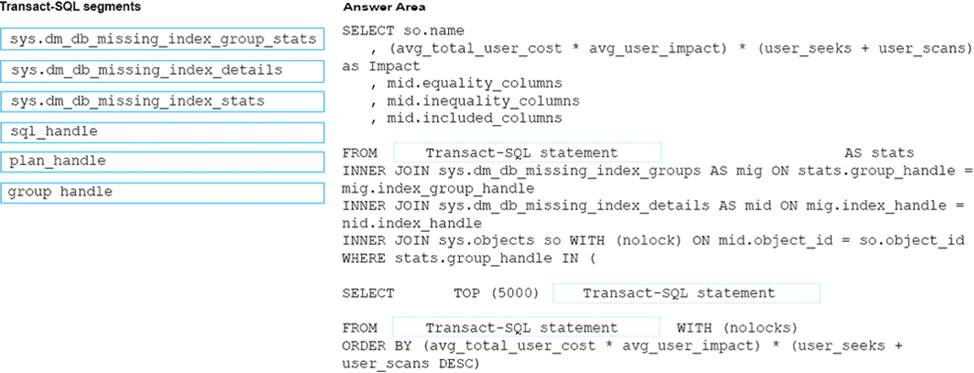
DRAG DROP
You are monitoring a Microsoft Azure SQL Database. The database is experiencing high CPU consumption. You need to determine which query uses the most cumulative CPU.
How should you complete the Transact-SQL statement? To answer, drag the appropriate Transact-SQL segments to the correct locations. Each Transact-SQL segment may be used once, more than one or not at all. You may need to drag the split bar between panes or scroll to view content.
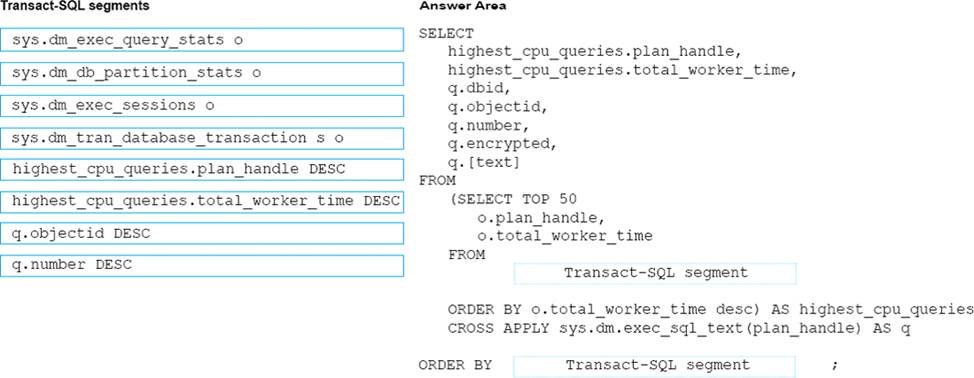
DRAG DROP
You are analyzing the memory usage of a Microsoft SQL Server instance.
You need to obtain the information described on the following table.

Which performance counter should you use for each requirement? To answer, drag the appropriate performance counters to the correct requirements. Each performance counter may be used once, more than once or not at all. You may need to drag the split bat between panes or scroll to view content.
NOTE: Each correct selection is worth one point.

Latest 70-762 Dumps Valid Version with 157 Q&As
Latest And Valid Q&A | Instant Download | Once Fail, Full Refund

